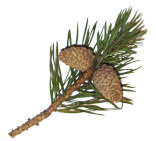NB: Help needed with this topic: see bottom of page.
Ancestor of our future king.
Validating the work of the late Douglas Grant
Background
This page builds on the work of the late Douglas Grant of Washington, Tyne and Wear. Douglas was an early participant in the Grant DNA project. I made contact with him because in my view his DNA profile was an albeit weak match for the chiefly line. As we discussed what he already knew about his family background (he came from a family of horse breeders from Louth in Ireland) we were both amazed that the horses his family bred were called the Strathavon Horse – and he had no idea that this was a reference to Stratha’an in Grant territory in Strathspey. This served to invigorate Douglas’ researches even though he had to interweave them between completing his PhD and family, work and volunteering with the army cadets (he had been in the army in his earlier career). This took him to places he could not have imagined when we first spoke.
His death from Covid19 came as a complete shock to me – but really it should not have as he had already shared that his immunity to disease was genetically weakened. Sadly none of the rest of his family shared his interest in his family line and so all the details of his researches were lost when he died – all I have are the memory of many phone conversations and telegraphic details in email.
Because all Douglas’ research notes have been lost/destroyed I cannot provide documentary proof for much of what Douglas uncovered. Here I present what I think I know as best I can. So on the one hand I may not have got everything right, but on the other hand anyone who might try to dismiss it out of hand clearly has an agenda of their own.
When we first discussed it, the closest match for Douglas’ DNA profile was with one which traced back to Glenlochy and Inverlochy in Stratha’an. It was I who leapt to the conclusion (working assumption) that this then linked to the MacRobbie Grants, descended from Robert, an illegitimate son of Robert Grant the Ambassador – but this turned out to be problematic and later it emerged both from other DNA profiles and from MS sources only later recovered that this supposedly MacRobbie DNA was actually from a cadet of the Grants of Tullochgorm (who appear to have married into the MacRobbie line when it failed to one or more heiresses).
Douglas could be an irascible character; patience with people who should know better was not one of his long suits and so there was a stand off with Geoff Grant of the DNA project. The problem was a single SNP which others in the chiefly line had, but Douglas did not. Geoff took this as axiomatic: he could not be a member of the chiefly line. There were two problems with Geoff’s perspective: (a) the fact is that SNPs can recombine (see DNA page on this site) and (b) we do not know when the SNP occurred – and this is where Geoff fell into another trap as his instinct is to ascribe far too great an age to these things.
Notwithstanding any of that, the recombination of SNPs is rare and should not be assumed. Before Douglas’ untimely death (in his early 50s) I had shared with him some blue sky thinking which would resolve matters but, sadly, it is only too late for him that my hunch turns out to have such substantial circumstantial support, that the dots can now be joined with considerable confidence.
This page also serves as a call for help: Hopefully someone with a direct connection to this line will come forward, pick up the too few pieces on offer and run with them.
Who was Alan Grant
There is no doubt (even Fraser accepts) that a John and an Alan Grant were present at the Battle of Halidon Hill in 1333. The John Grant involved was later to become Sir John Grant and his wife was Elizabeth Gordon. Alan Grant was his younger brother. At Halidon Hill John would have been about 26 years old, his bother about 23. They had a younger brother Thomas who would become a “burgess of Aberdeen” and was the father of the boys who went with Sir John to France in 1359 (see page about the Vicomtes de Vaux). But of Alan no more is heard. And now we know why…..
The Life of Sir John Grant
John Grant signed up to join the Scots regiment under William, 1st Earl of Douglas which fought on the French side at the Battle of Poitiers (1356). Whether or not he had played a part in Douglas’ previous adventures I cannot say. Like the Earl, John was knighted by the French king on the eve of the battle and unlike the king he was captured by the English army under the Black Prince. He was held for a time at Kenilworth, but acquitted himself so well that not only was he released on parole, he was even given a parcel of land in Exelby, not far from Richmond Castle. Shortly thereafter even Fraser recognised that he was given Safe Conduct passes to move freely between England and Scotland in 1357 and 1358 and again in 1366.
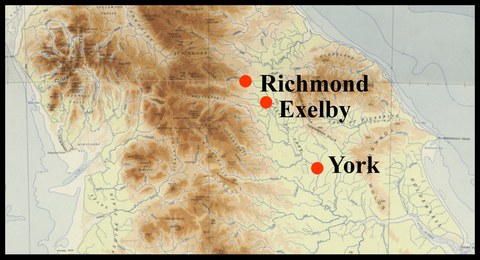
Base map: maps.nls.uk
With all his experience it is no surprise that in 1359, as noted above, he was part of the Embassy to France together with Sir Robert Erskine and Normal Leslie.
About Glenbeg in Inverallan
On the page about Marjory Lude we noted how Maurice, younger son of Maud Grant and Andrew (Stewart) Grant was awarded “half of the Barony of Freuchie” which eventually descended to her.
Now we should note that Patrick “beg” awarded the bulk of the rest of his share of Inverallan – “the Barony of Freuchie” to his daughter Elizabeth and her husband William Pylche. These were the lands of Dreggie and Glenbeg.
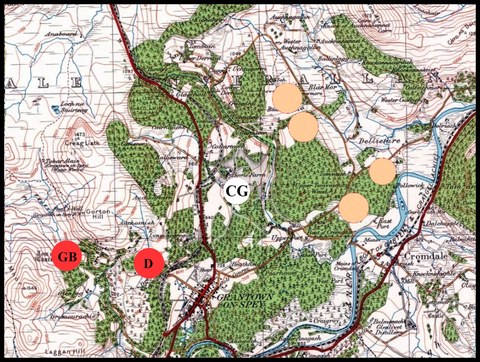
Map of Glenbeg: maps.nls.uk
- GB: Glenbeg
- D: Dreggie
- CG: Castle Grant
- Buff circles: Maurice Grant’s estate
There are two problems with this grant:
- It is very substantial – much more than the sort of “tocher” one might give to a prospective son-in-law.
- It was given very late in the marriage. Elizabeth was born no later than 1320, potentially as early as 1303. Yet the charter could not have been given before 1357.
One of the witnesses to the charter was “Alexander Bishop of Ross”. There were two such Alexanders in succession, 1350x71 and 1371x98, but Fraser narrows the time window down to 1357x62 (perhaps due to the relevant dates of one of the other witnesses) – which I will accept. At this point Patrick beg was about 80 years old! This charter has a whiff of panic about it – it seems as if there was a void which needed filling in short order.
So why was Patrick panicked into making this gift? My answer is deceptively simple: Alan Grant, Sir John’s brother, had been given these lands in the normal course of events, but now Sir John had infeft Alan with his land at Exelby and so suddenly there was a vacancy in Glenbeg. Sir John’s son Robert was an only son, so there was no younger son to confer the estates on, so the gift to the Pylches was an act of desperation intended to keep the land in the family. The dates tie together extremely well – far too much for it to be coincidence – and the transfer was seamless.
What Alan’s family did next
Another safe conduct was granted to a Robert Grant other than Chief Robert Grant the Ambassador to come and go freely to trade in England. I have interpreted this as:
- The Robert concerned was an illegitimate son of Chief Robert
- That he was given Glenlochy and Inverlochy as his base
- That he coordinated horse breeding in Statha’an and neighbouring areas which he took to his cousins’ lands in Exelby to trade.
Economically: For about a hundred years the Grants had something of a monopoly over a significant part of the horse trade – they certainly traded with Royalty, They diversified vertically becoming involved with slaughterhouse products including glue and the Liveried Company of Glovers. Along with this came a geographical expansion. Key members of the family moved South into Warwickshire, being particularly associated with Norbrook in Snitterfield.
But then came the wars of the Roses. The Grants sold horse to both sides, but after the succession of Henry Tudor they lost their special privileges and had to diversify. They started breeding horses on Dartmoor (whence a connection to the Founding Fathers of America) and extended into Ireland (whence Douglas’ ancestry in Louth).
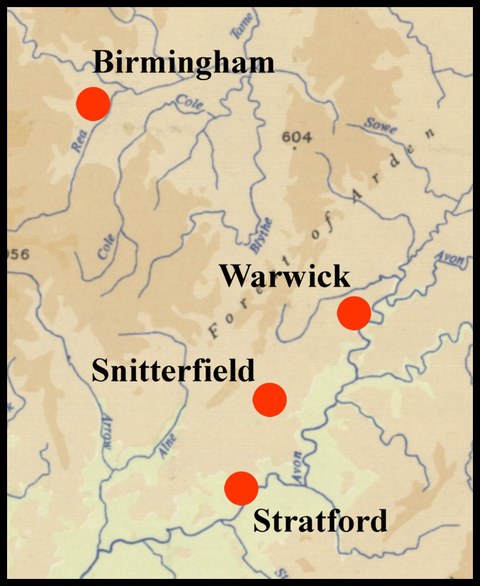
Base map: maps.nls.uk
Politically: The Grants stayed close to the court for a long time, at least one serving the king as Groom of the Stool (which king is now lost to me).
The Snitterfield branch was closely associated with the Spencers, Sir John Spencer of Snitterfield and Wormleighton born in 1460 married Isabel le Graunte (b. 1474) in 1489. [It is interesting to note that when Sir John was born his father was just 15 and his mother 12.] Thus Alan Grant and his forebears are ancestors of Diana Princess of Wales and Prince William our future king.
The Snitterfield branch was also closely associated with William Shakespeare’s family (especially via the glove-making trade) and around this time with the Gunpowder Plotters.
John Grant, one of those executed for his involvement. He was married to the sister of Thomas Wintour, another of the plotters and amongst their children was Wintour Grant who appears to have left for the English College of Douai where he may have taken Holy Orders.
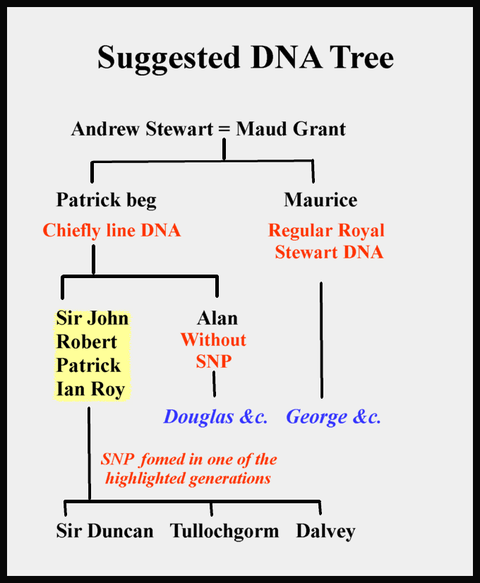
Summary
What we can see is that
- Alan Grant was born about 1310. Isabel Grant’s father, Walter, was born in 1448, so it appears that there are just 5 intervening generations between Alan and Walter.
- John Grant, the Gunpowder Plotter was born in 1570 – with just 4 intervening generations. John’s father was Thomas Grant (see some more detail here).
So it should not be too difficult for someone on the ground locally with an interest to fill in some more of the details.
Postscript
Douglas Grant had amassed an enormous amount of detailed information and given his academic background I am sure that it was all properly referenced. All I have been able to do here is to allude to it, I hope accurately.
